I’m in Carmel, Indiana tonight, to work on a project with the Allegion Marketing team tomorrow. I stopped at an outdoor mall to replace something I forgot to pack (I know some of you are tempted to guess what I forgot, but let’s let it go and focus on the question below :)). As I was checking out the variety of doors in the mall, mostly aluminum storefront, it reminded me that I’ve been meaning to get some input on this:
What is your preferred method for hanging an aluminum storefront door, and why? What are the considerations – aesthetics, function, durability…others?
Pair 1 has butt hinges – I didn’t whip out my tape measure, but 4 hinges per door leaf usually indicates a door that is more than 90 inches tall.
Pair 2 – Hinges again…what do you think about the back-to-back pulls with no horizontal push bar across the glass?
Pair 3 has 3 hinges per leaf, and an application that’s one of my (many) pet peeves. If you know what it is, what product application would you propose instead?
Pair 4 – I went through a pivot phase at one point…probably because of the fancy projects I was working on at the time. Do any of you have a preference for pivots? This pair has only top and bottom pivots. Also – the bottom rails don’t meet the requirement for a 10″ flush surface.
Pair 5 has intermediate pivots along with the top and bottom set. What about these pulls? Do you think they meet the accessibility standards?
Pair 6 has geared continuous hinges. If continuous hinges are your preference for aluminum storefront, do you like to use geared or pin-in-barrel type?
This is unrelated to the hinge question, but I was looking for a photo of a rain drip the other day and saw this one at the mall. If I’m remembering my hardware school lessons correctly, there appears to be a problem with the installation of the drip…can anyone see the issue?
Also unrelated but I saw this during my shopping trip and thought it was kinda cool…the storefront shown here is actually printed on fabric to cover a temporary wall during construction. There’s a temporary door under the fabric, and the creative locking method is pictured below.
Now, back to the question of the day…what type of hanging mechanism is your preference for aluminum storefront, and why?
You need to login or register to bookmark/favorite this content.


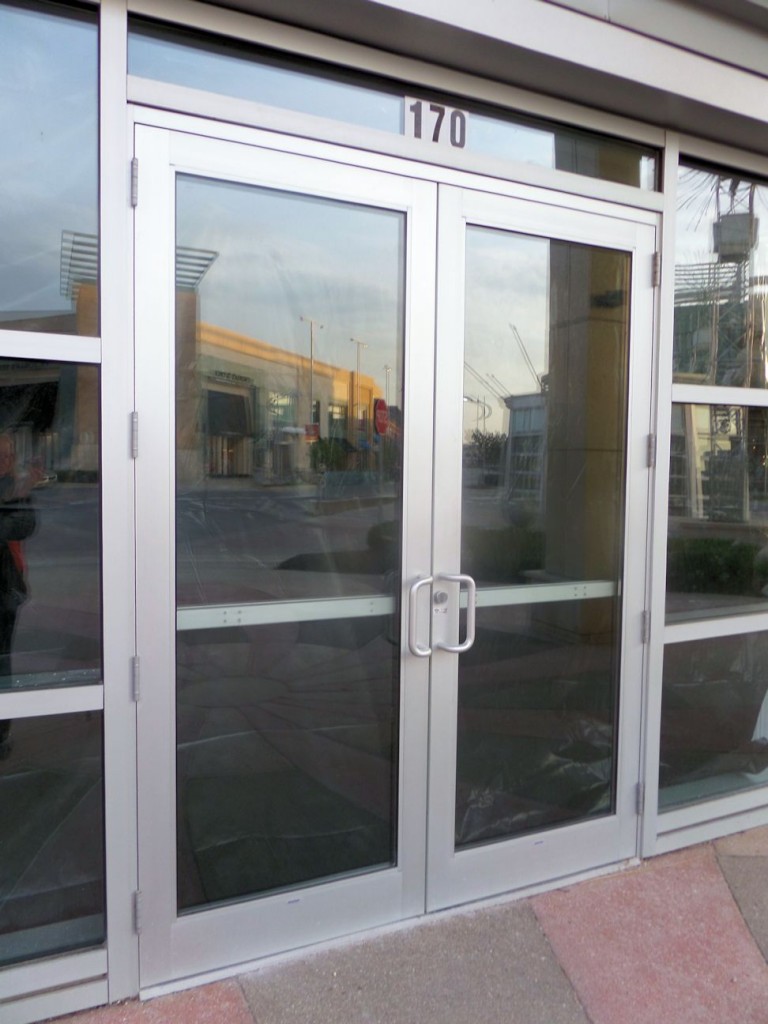
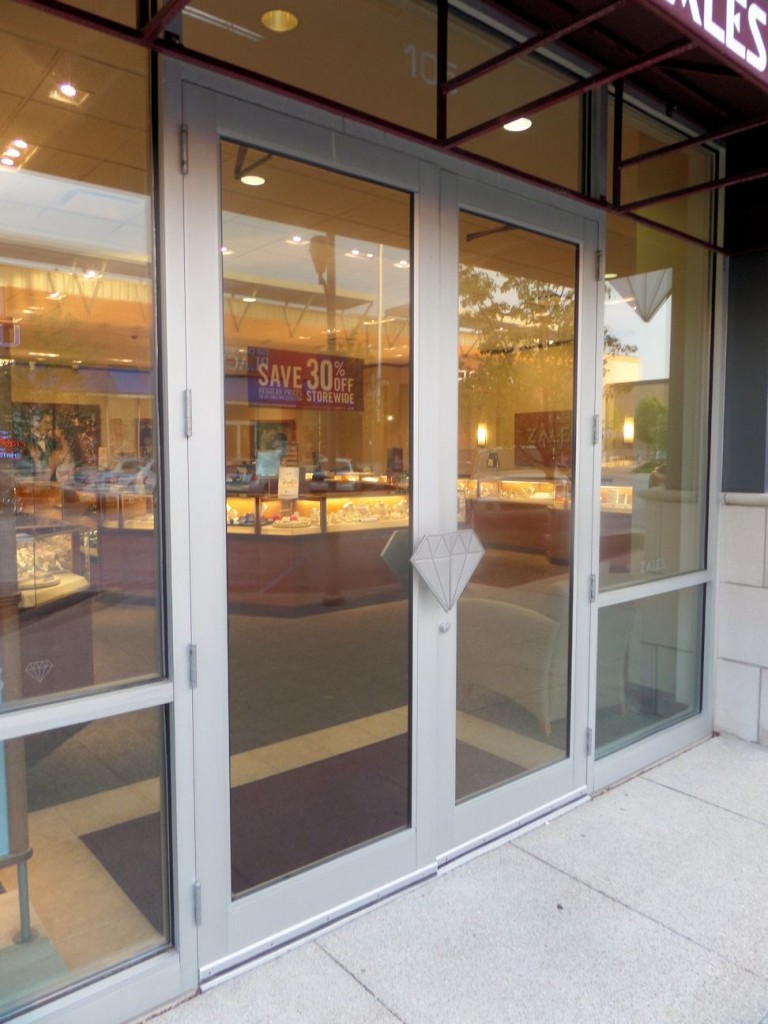
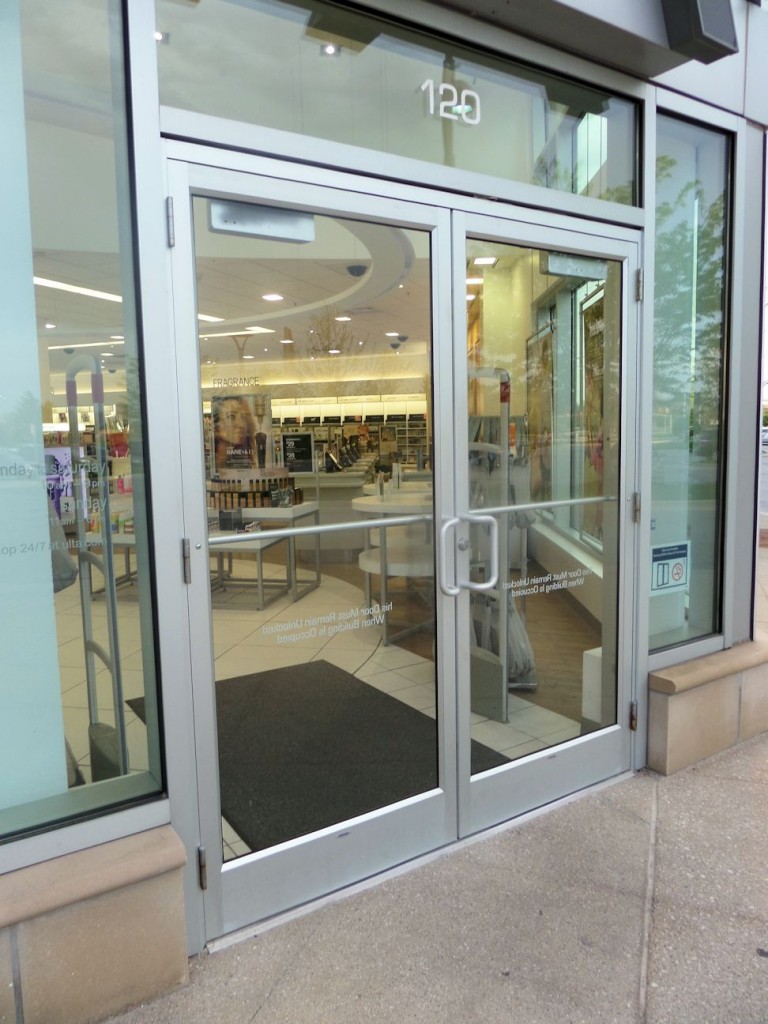
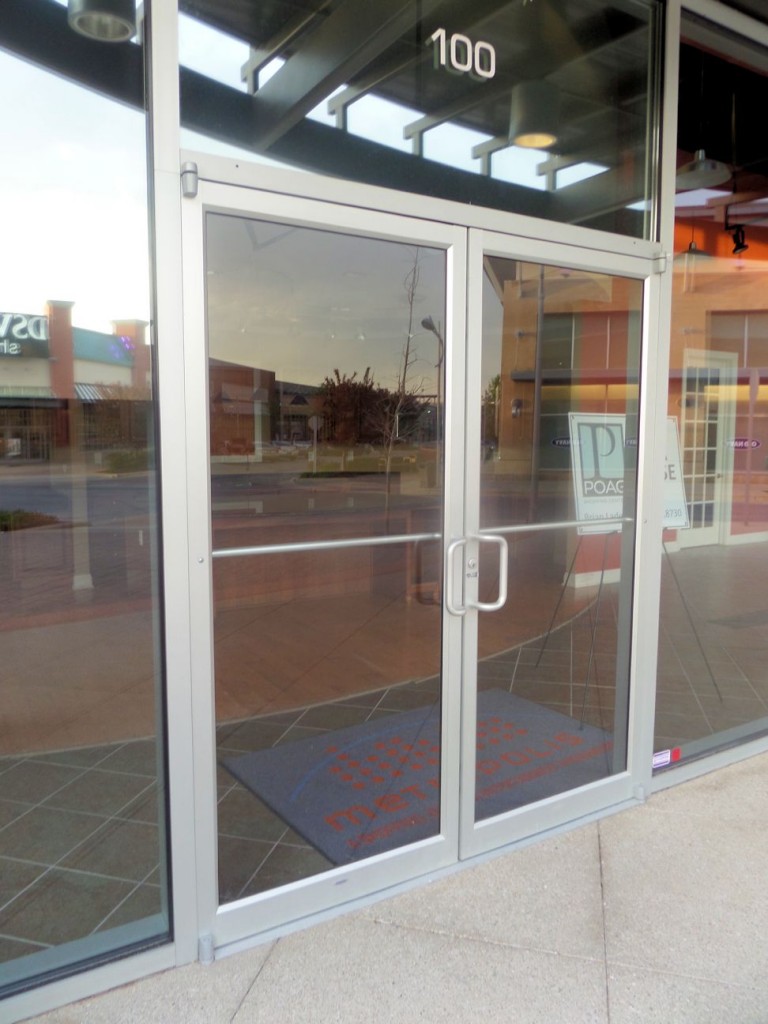
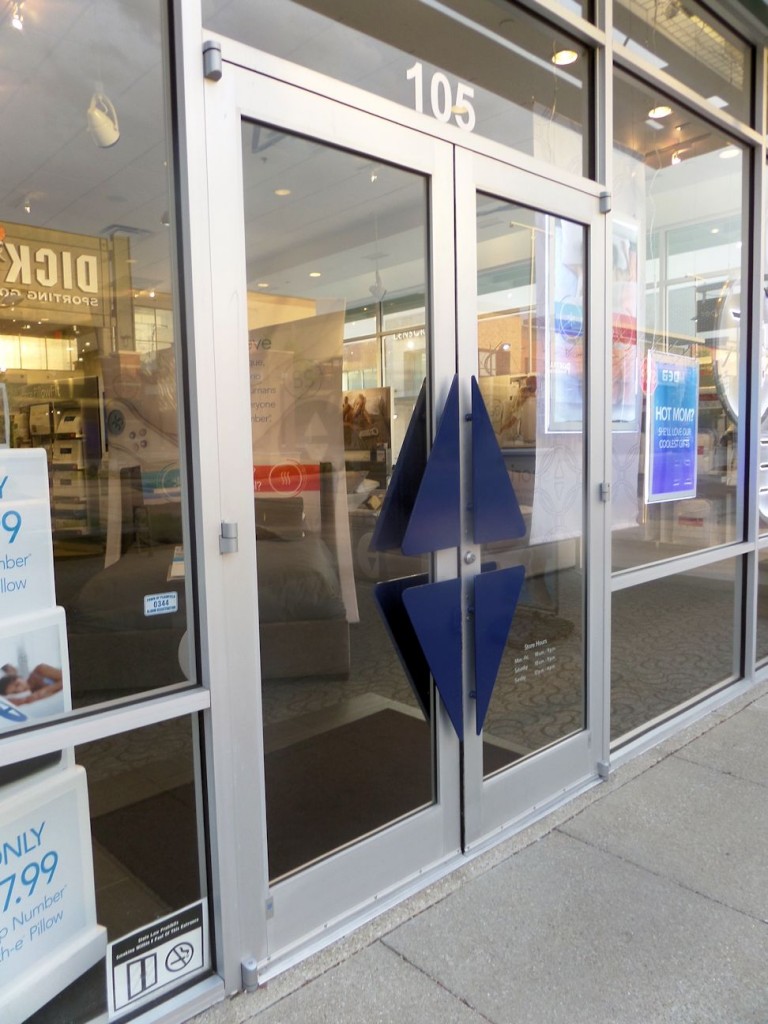
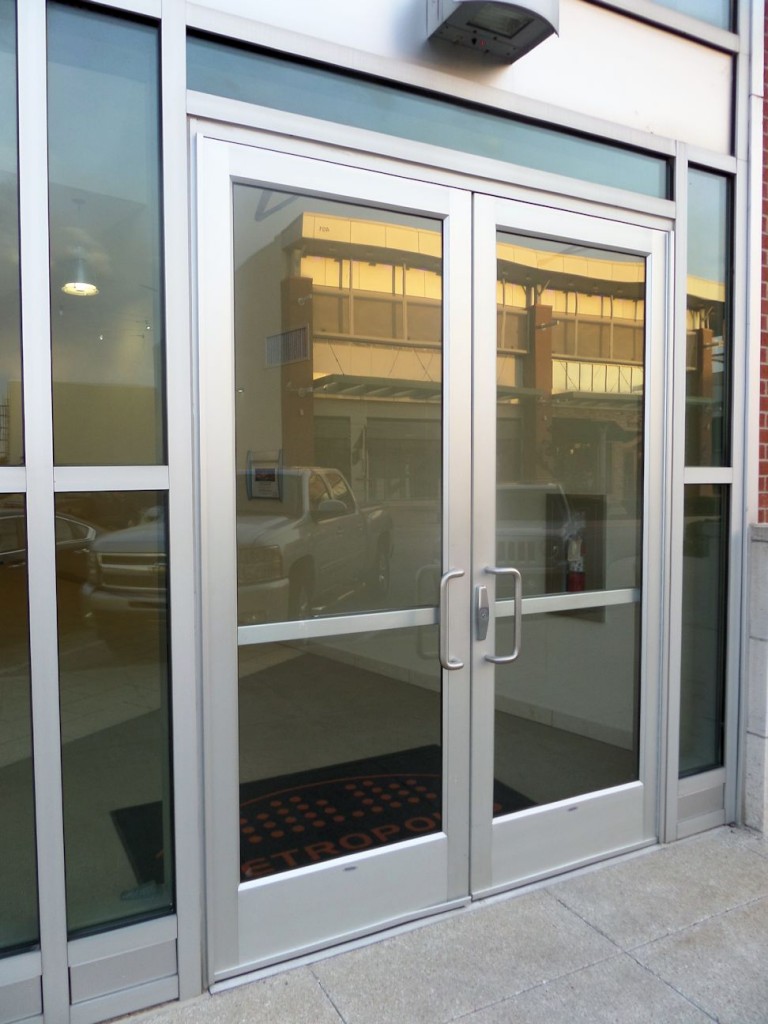
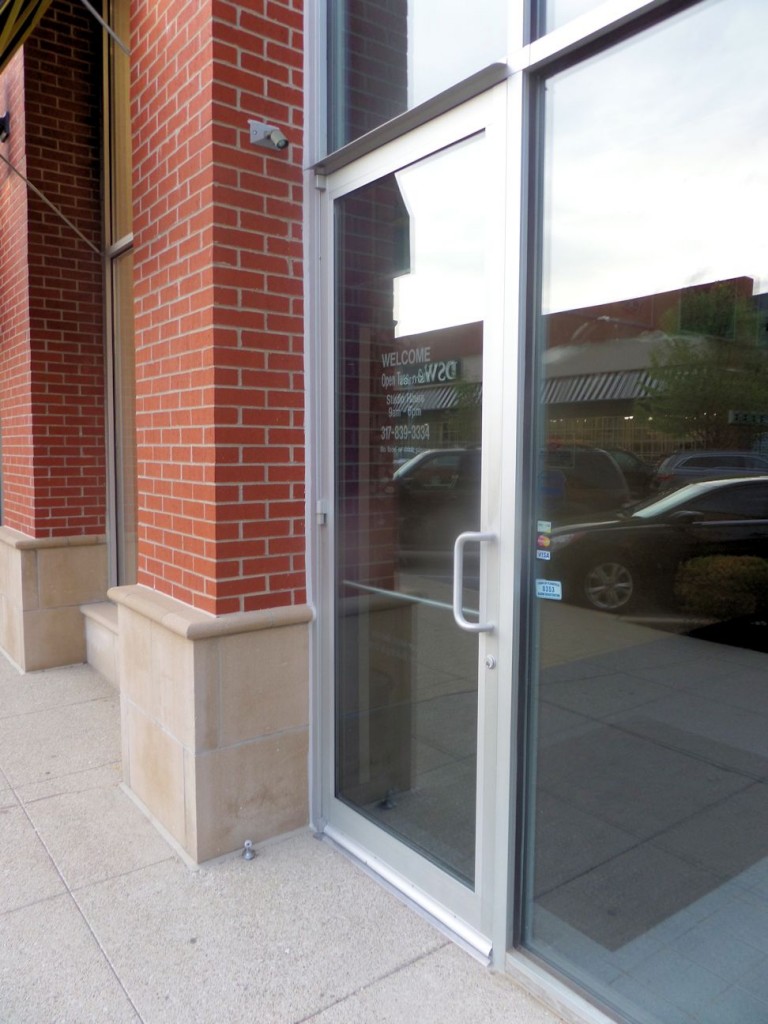
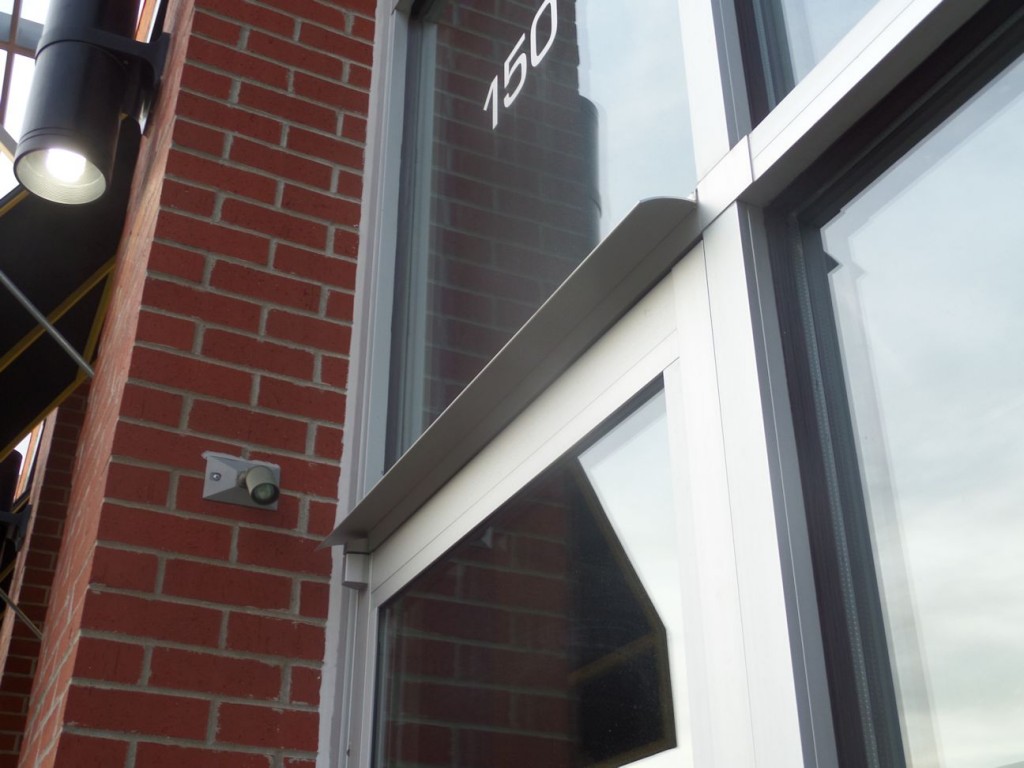
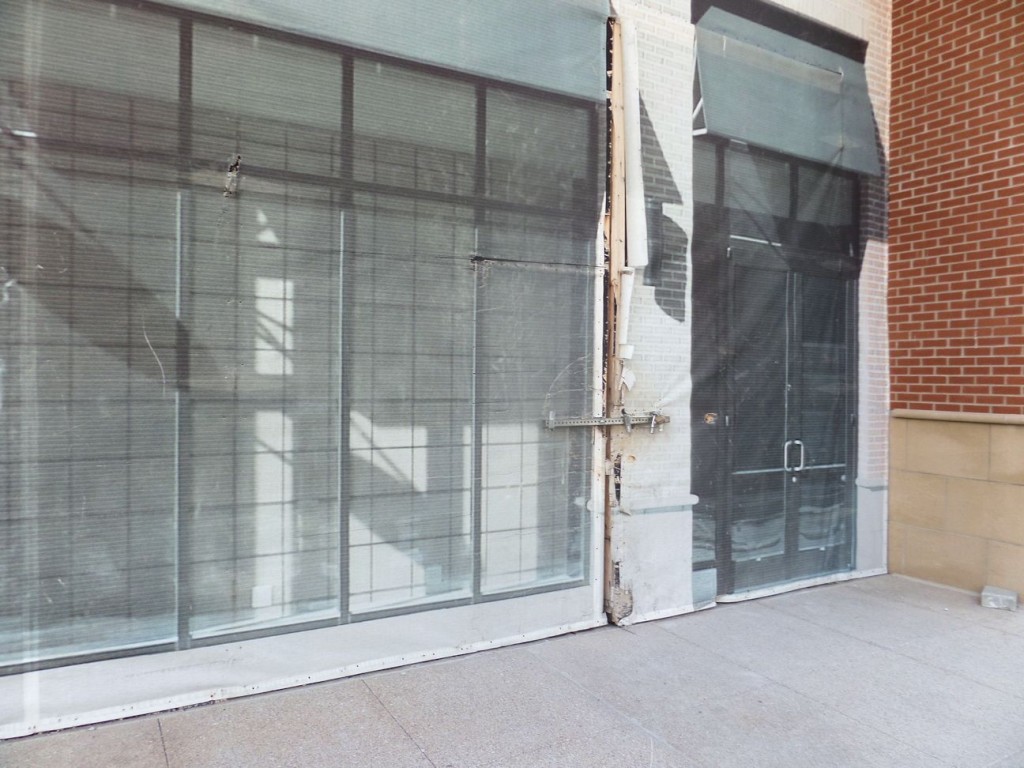
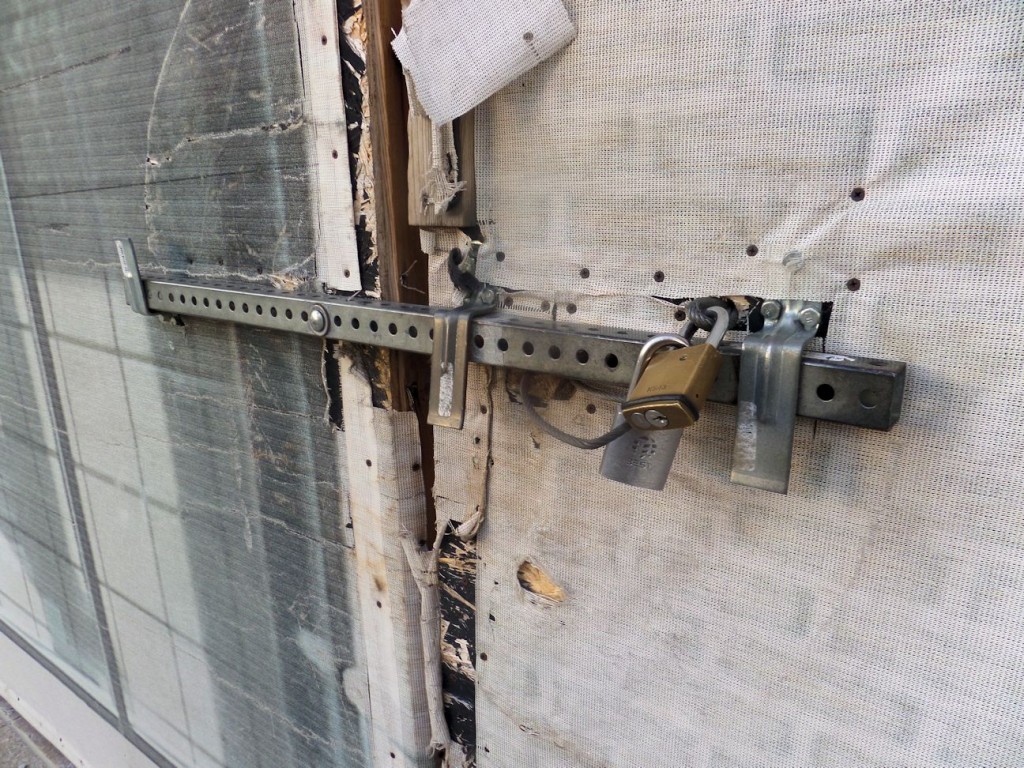




Lori – In my career I went from hinges to pivots to pin/barrel continuous hinges and finally to the geared continuous hinge. An architect told me that I finally got it right when I filled in the gap between hinges, and the hinge blended into the opening by matching the opening. All worked. Appearance was the most important aspect to my clients.
Pair 3 has top jamb mounted closers with drop plates that can be seen thru the glass. Could have used a slim line closer (1461) or concealed.
Drip cap must be installed from outside of vertical frame to outside of vertical frame to be effective.
Be careful with the marketing team.
Bruce
The pet peeve has got to be the closers showing through the glass. Should be mounted top jamb.
I prefer a center hung like the Rixson 340 walking beam and a floor check. Or the Jackson/Kawneer COC with a center hung bottom pivot.
Either gives the cleanest lines along with putting as much of the hardware out of both sight and the weather. Plus being center hung, they just seem to last longer.
That’s interesting! I don’t see many center pivots on storefront doors. You don’t find that the lack of intermediate pivots is a problem?
I think center hungs have went out of style due to the upfront cost versus a bolt on closer and offset pivots.
Take a look at any Herculite door that you see and it will normally have patch fittings similar to a center hung. Those weigh a lot more than an aluminum storefront and never have center pivots.
I was recently at a facility that went well back into the 60’s and their main entrance was center hung with a floor check.
They couldnt remember the last time it was worked on and it appeared original.
Geared continuous hinges because of continuous support and durability.
The overhead rain drip does not extend beyond the edge of the door.
Did you notice that several of the aluminum door bottom rails do not comply with the 10″ minimum ADA requirement?
I did notice the bottom rails but I forgot to mention them…I just added a note to the blog post about that. Thanks Morriss!
We use geared cont on our school projects for all exterior doors. Very sturdy. Also helps seal the joint. And we get no arguments from the alum suppiers who… We do ask for a steel reinf in both door and jamb.
In photo 3 I’m guessing the “exposed” closers. We never spec narrow style in schools but a 5″ head rail can be requested. Or a smaller lighter duty (those are 4100?) or a concealed – head or floor.
I’m so glad to hear that you don’t spec narrow stile doors in schools…they don’t hold up as well, and they don’t accommodate the type of hardware that most schools prefer.
The drip cap…it doesn’t extend 2″, to both sides, over the width of the door.
You got it Beth!
Nice question!
Hang-the-door: My first preference (not shown) is to set that door on a floor closer and use intermediate & top pivots — very efficient. Next choice (more often than flr clsrs due to cost) is to use an aluminum geared type continuous hinge (Pair 6) — the hinge “disappears” as part of the storefront system — best-looking choice IMHO. Third choice is btm + int + top pivot set. Don’t like butt hinges in a storefront opening.
Close-the-door: If I’m not using a floor closer, then I prefer a top-jamb mounted large-bore surface closer with a metal cover, and if using brushed “white-metal” hardware finishes, have that closer powder-coated with a high-metallic content finish — it looks as though it’s been plated, and actually makes the closer more easily visually dismissed rather than the not-as-well-matched std 689/”ALUM” finish (better-looking makes it “go away”). Top jamb mounting is more efficient than parallel-arm, less noticeable, and farther away from people, and we don’t get the ugly drop plate showing through the glass as in Pair 3.
Thanks Tom! I like the metallic powder coat too. With painted doors I like to use a custom powder coat color on the closers to make them “go away”, but it’s hard to get anyone to focus on this level of coordination unless the job is high profile.
Drop plates are still preferable to in the floor closers.
It’s funny – it depends on what part of the country you’re in. We don’t use floor closers on exterior doors very much in New England, but Tom Breese is from California and a floor closer was his first choice. The weather causes too many problems for floor closers here, and probably for you in Ohio too.
Is your pet peeve for the 3rd set of doors the closer drop plates?
You know me so well. 🙂
Picture #1.)Experienced door builder that is proud to over engineer the opening to reduce call backs and customer complaints. If it is over 90″ it can’t be by much.
Picture#2.)Somebody has to go back to school and learn to count! New math maybe. Line up the attorney’s for broken glass suits and door pulls in a few people’s face and eyes.
Picture #3.)Great built in door stops!
Pictures 4+5.) Love to remove pivots and install continuous hinges
Picture #6.)I have always used geared hinges myself. No prejudice…just have.
Pictures 7+8)Other than having to remove the cap for pivot service and possibly blocking the camera view, what could be wrong!
Gotta run.
Hi Ronald – On pics 7 & 8, the rain drip should be 4″ wider than the door opening, so it extends past the door edge to divert the water away.
A couple comments:
1. So you don’t like using drop plates that you can see through the glass?
2. I like using geared continuous hinges. They keep the door from sagging. A pretty clean look and they seem to hold up real well over time.
3. Back in the stone age, we were taught that the overhead drip cap should be 4″ wider the opening.
No, I don’t like to see the closers. My preference would be wider top rails but second choice would be top jamb mounted closers.
Hinges is the only way we allow aluminum store front doors to be hung and we always specify four hinges. One reason for hinges is you can always easily shim the hinges and if you have problems with the hinge reinforcement bending it can easily be replaced with a hollow metal hinge reinforcement and the problem is usually solved. We only allow wide style door, welded corners, flush top cap, a cross rail behind the rim panic devices, E996L lever trim, & a keyed removable mullion. For non-locking or push/pull doors they still must be wide style with a cross rail behind the push bar but the push bar must have the gap behind it filled in to the cross rail so there is no way for someone to chain or wire the doors shut. The pulls must be straight not off set and must have a 3/8 bolt through the door and that solves the broken bolt problems and we still have a keyed removable mullion that the doors shut against as this keeps the doors straight. We also do not allow doors over 8′ tall or over 3’6″ wide. We prefer to keep them 3’0″ x 7,0″ and we have a lot less problems with wind or positive or negative building air pressure when we do that. I really prefer not to use aluminum store front doors and instead use a SteelCraft stile and rail door but that is no long a possibility and that is really too bad as it was a far superior product then any aluminum store front door will ever be. The other thing I noticed is that the bottom rail of most of the doors shown do not appear to meet the ADA standard of a minimum height of 10″. If the doors are push/pull only we always require the push side have a cross bar so it is clear to people which side is push and which side is pull. The pulls in Pair 5 does not appear to have clearance behind the pull needed to meet ADA standards. The rain drip does not extend the 3-4″ past the edge of the door.
Thanks for the insight, Elson! I love a facility with solid standards!! 🙂
Geared continuous hinge!
It looks better than other types.
We have used cont. hinges both P & B and geared, pivots and butt hinges. Good applications but not as durable as you would expect. Asthetics aside; durability should be the determining factor. Top rail and stiles should be minimum 6″, bottom rail 10″. Heavy Duty 5 ” ball bearing anchor hinges have shown to be the best solution at our facility. Door sag and vertical nylon gear wear is not a factor. Heavy Duty pivots (intermediate included) would be choice#2.
For the closer….either OHC or surface applied top jamb mount.
Love floor mounted closers on the exterior in Chicagoland.
Even better I love the look on owners/managers faces when they see the estimate/bill.
Same with 3/4 offset pivots, Chicago weather and all the salt rusts those out quickly, but the repairs are less expensive.
Butt hinges are great especially when the wind grabs the doors and tears the aluminum, or contorts the backing plate in the frame.
For my money, continuous geared aluminum hinges every time.
As for the A.D.A. bottom rails…I’m waiting for the AHJ to start enforcing it on every door, old and new.
and I hope they call us.
Lots of storefronts in the Chicagoland metro area.
Vince
*Lots of sarcasm above.
The first 7 pictures are all saying the same thing. Yank here to break the mounting bolts of the offset pulls. I am trying to get them outlawed in our new construction but the Archaic-itects are fighting it.
I agree with Elson!
At our school district, we spec heavyweight stainless steel BB butt hinges and mounted on zinc-plated or stainless steel backup plates. The doors are also spec’d to be heavywall doors and the immediate door frame members must also be heavy wall (.188mm / 3/16″ thick)
The advantage here is that the hinge swage can be adjusted to realign the door to compensate for any sag or building and concrete floor movement. Continuous hinges didn’t have any allowance for minor adjustments until I saw the Ives 157XY. I haven’t tried these yet but they have piqued my interest.
The other facets of our aluminum door specs are that they must have welded and fastened corners. Some companies only bolt the doors together and it allows the door to fall out of square over time.
We also use wide stile 5″, 8″ top and center rail, and 10″ bottom rail.
One of the details I haven’t seen anyone else use is the lock stile must be beveled on double doors like the single doors. Most aluminum door manufacturers have some form of meeting stile that is adjustable, but it ends ups causing more problems than it solves. Since we use keyed removable mullions, we put a weatherseal on the face of the mullion and there is no meeting stile to potentially interfere with the ease of self-closing on either door.
Which gasketing do you use on the mullion?
I use Pemko 5110BL. It doesn’t provide a perfect seal but nothing really does.
full length geared hinges with LCN 2030 CONCEALED CLOSERS AND VON DUPRIN PANIC DEVICES IS WHAT WE LIKE, THE OTHER PANIC DEVICES ARE A JOKE AND IF YOU NEED PARTS TO REPAIR THESE DOORS THEY ARE AVAILBLE FAST UNLIKE THE OTHER BRANDS, HOWEVER NOT EVERYBODY IS WILLING TO DO THE TOP SHELF REPLACMENT OR INSTALL SO THAT IS WHEN THE OTHER BRANDS COME IN TO PLAY AND MY SECOND CHOICE OF PANIC DEVICE WOULD BE JACKSON FOR THE EASE OF INSTALL AND REPAIR. AS FAR AS PULL HANDLES THERE IS A UNIVERSAL PULL HANDLE THAT IS STRONG AND STURDY AND WILL FIT ANY DOOR. IT HAS BEEN AROUND FOR THE LAST FOUR YEARS IN CALIFORNIA AND WE USE THEM EVERY DAY.
I for one prefer the continuous gear hinges, and the butt and barrel hinges as an alternative. From my experience it is only a matter of time before pivots fail, especially on exterior doors in climates where the ground is subject to heaving. A little bit off topic, in Saskatchewan, the Adams Rite 4500 deadlatches or equivalent knockoffs are the most often used on apartment buildings, stores etc. They appear to have a very high failure rate often preventing occupants from leaving the building. What alternatives have you found that work better on narrow profile store front doors?
Hi Mario –
Unfortunately I don’t know of a good alternative to the Adams Rite locks, unless you go to panic hardware (I know that can be cost-prohibitive).
– Lori